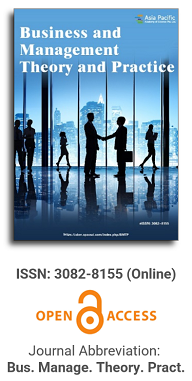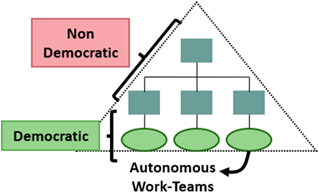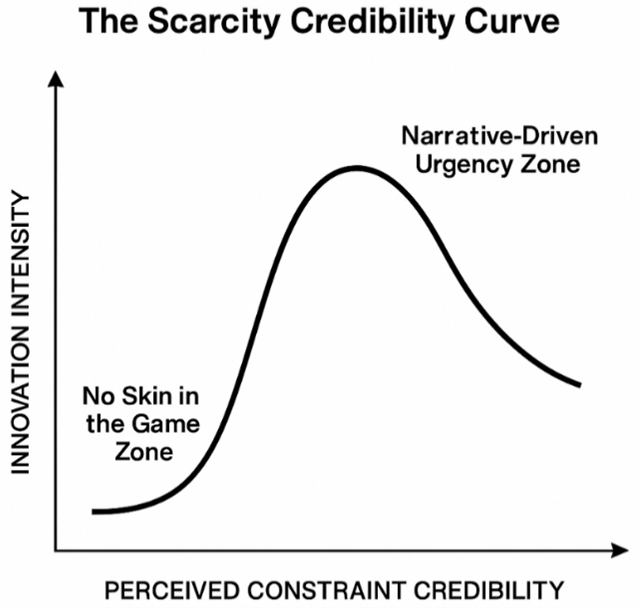
Asia Pacific Academy of Science Pte. Ltd. (APACSCI) specializes in international journal publishing. APACSCI adopts the open access publishing model and provides an important communication bridge for academic groups whose interest fields include engineering, technology, medicine, computer, mathematics, agriculture and forestry, and environment.


Alternatives to bureaucracy based on worker participation and horizontal management: Why do they work?
Vol 2, Issue 2, 2025
Download PDF
Abstract
Administration is an academic field that is showing signs of maturity, with a theoretical and practical mainstream that has been consolidated around Weberian bureaucracy, a management paradigm with numerous examples suggesting that it may be reaching its limits in terms of the new advances it can offer the discipline. On the other hand, the shift to a paradigm that transcends it (while retaining all its virtues) requires not only successful empirical counter-examples, but also a consistent alternative theoretical corpus that gives academics and especially practitioners the confidence to adopt it. In this sense, through “integrative” literature review-based research, the article intends to outline a scholarly narrative that provides concrete theoretical underpinnings to explain, in a systematic and concise manner, why management styles that depart significantly from bureaucratic orthodoxy are stable (i.e., do not diverge towards “chaos and anarchy”), while also proving effective and efficient. As a result of the analysis carried out, an intertwined combination of contributions about alternatives to the classical bureaucratic arrangement is obtained, sourced from studies of different time periods. Thence, based on four conceptual axes (self-actualization, objectives, capabilities and monitoring), the elaboration of a theoretically integrated explanation for the sustainable viability of participatory and horizontal management is achieved. This article’s contribution points towards the future possibility of consolidating novel approaches that virtuously supplant the current bureaucratic mainstream.
Keywords
References
1. Drucker PF. Management: Tasks, responsibilities, practices. New York: Harper & Row; 1974.
2. Simon HA. Organizations and Markets. Journal of Economic Perspectives. 1991; 5(2): 25-44. doi: 10.1257/jep.5.2.25
3. Hamel G, Breen B. The Future of Management. Harvard Business School Press; 2007.
4. Adler PS, Borys B. Two Types of Bureaucracy: Enabling and Coercive. Administrative Science Quarterly. 1996; 41(1): 61. doi: 10.2307/2393986
5. Rothschild J, Whitt JA. The Cooperative Workplace: Potentials and Dilemmas of Organizational Democracy and Participation. CUP Archive; 1986.
6. Foss N, Klein P. Why managers matter: The perils of the bossless company. PublicAffairs; 2022.
7. Getz I, Carney MBM. Freedom, Inc.: How Corporate Liberation Unleashes Employee Potential and Business Performance. Somme Valley House; 2015.
8. Hamel G, Zanini M. Humanocracy: Creating Organizations as Amazing as the People Inside Them. Harvard Business Press; 2020.
9. Laloux F. Reinventing Organizations: A Guide to Creating Organizations Inspired by the Next Stage of Human Consciousness. Nelson Parker; 2014.
10. McGregor D. The human side of enterprise. McGraw-Hill Book Company, Inc; 1960.
11. Parker Follett M. Dynamic administration: The collected papers of Mary Parker Follet. Harper and brothers; 1940.
12. Trist E. The Evolution of Socio-technical Systems: A Conceptual Framework and an Action Research Program. Ontario Ministry of Labour, Ontario Quality of Working Life Centre; 1981.
13. Monteiro P, Adler PS. Bureaucracy for the 21st Century: Clarifying and Expanding Our View of Bureaucratic Organization. Academy of Management Annals. 2022; 16(2): 427-475. doi: 10.5465/annals.2019.0059
14. Emery F, Thorsrud E. Democracy at Work: The Report of the Norwegian Industrial Democracy Program. Martinus Nijhoff Social Sciences Division; 1976.
15. Ackoff RL. The Democratic Corporation: A radical prescription for recreating corporate America and rediscovering success. Oxford University Press; 1994.
16. Kuhn TS. The structure of scientific revolutions. Chicago: University of Chicago Press; 1970.
17. Gonza T, Ellerman D, Juri KM. Democratic ownership: Scale through leveraged conversions.In: The Routledge Handbook of Cooperative Economics and Management. Routledge; 2024.
18. Puusa A. Critical issues of co-operative governance in large co-operatives: Who eventually wields power? In: The Routledge Handbook of Cooperative Economics and Management. Routledge; 2024.
19. Estragó A. Duality and dissonance in worker cooperative management (Spanish). Ciencias Administrativas. 2020; (17): 078. doi: 10.24215/23143738e078
20. Estragó A. Exploring potentials and challenges of horizontal management: A mixed study of two software worker cooperatives in Argentina (Spanish). REVESCO Revista de Estudios Cooperativos. 2023; 145: e91413. doi: 10.5209/reve.91413
21. Estragó A. Measuring the Organizational Horizontality in Argentinian Software SMEs: The “Worker Ownership – Horizontality of Management” Scale. The Journal of Entrepreneurial and Organizational Diversity. 2024; 13(1): 1-31. doi: 10.5947/jeod.2024.001
22. Meyers JSM. Participatory Bureaucracy: Addressing Gender Inequality in Worker Cooperatives. The Journal of Entrepreneurial and Organizational Diversity. 2022; 11(1): 23-54. doi: 10.5947/jeod.2022.002
23. Pek S. Sortition and the democratic governance of cooperatives. In: The Routledge Handbook of Cooperative Economics and Management. Routledge; 2024.
24. Wren D. Joseph N. Scanlon: the man and the plan. Journal of Management History. 2009; 15(1): 20-37. doi: 10.1108/17511340910921763
25. Trist EL, Bamforth KW. Some Social and Psychological Consequences of the Longwall Method of Coal-Getting. Human Relations. 1951; 4(1): 3-38. doi: 10.1177/001872675100400101
26. Cummings TG. Self-Regulating Work Groups: A Socio-Technical Synthesis. The Academy of Management Review. 1978; 3(3): 625. doi: 10.2307/257551
27. Estragó A. Management in worker cooperatives: Democracy vs. dissonance, and possible overcoming approaches. Journal of Co-operative Organization and Management. 2023; 11(2): 100216. doi: 10.1016/j.jcom.2023.100216
28. Achterbergh J, Vriens D. Organizations: Social systems conducting experiments. Springer Berlin Heidelberg; 2009.
29. Estragó A. Horizontal organizations: Old aspirations in management ideas that are being renewed (Spanish). Revista del Centro de Estudios de Sociología del Trabajo (CESOT). 2020; 12: 39-74.
30. Womack JP, Jones DT, Roos D. The Machine That Changed the World: The Story of Lean Production- Toyota’s Secret Weapon in the Global Car Wars That Is Now Revolutionizing World Industry. Simon and Schuster; 2007.
31. Adler PS. The Learning Bureaucracy: New United Motor Manufacturing, Inc. University of Southern California; 1992.
32. Buck JA, Endenburg G. The creative forces of self-organization. Sociocratic Center; 2010.
33. Romme G. Making organizational learning work: Consent and double linking between circles. European Management Journal. 1996; 14(1): 69-75. doi: 10.1016/0263-2373(95)00048-8
34. Schell S, Bischof N. Change the way of working. Ways into self‐organization with the use of Holacracy: An empirical investigation. European Management Review. 2021; 19(1): 123-137. doi: 10.1111/emre.12457
35. Robertson BJ. Holacracy: The New Management System for a Rapidly Changing World. Henry Holt and Company; 2016.
36. Manifesto for Agile Software Development. Available online: http://agilemanifesto.org/ (accessed on 2 February 2025).
37. Moe NB, Šmite D, Paasivaara M, et al. Finding the sweet spot for organizational control and team autonomy in large-scale agile software development. Empirical Software Engineering. 2021; 26(5). doi: 10.1007/s10664-021-09967-3
38. Hoda R, Murugesan LK. Multi-level agile project management challenges: A self-organizing team perspective. Journal of Systems and Software. 2016; 117: 245-257. doi: 10.1016/j.jss.2016.02.049
39. Ugarte L, Agirre A, Juaristi E. The cohesive power of new management alternatives: Principal components of the Irizar model. International Journal of Technology Management & Sustainable Development. 2009; 8(1): 13-26. doi: 10.1386/ijtm.8.1.13_1
40. Estragó A. The “new style of relationships”: a futuristic vision of organizational management? (Spanish). SaberEs. 2022; 14(1): 1-19.
41. K2K Emocionando. Experiencias NER 2011. Available online: https://nerbyk2k.com/wp-content/uploads/experiencias_ner_2011.pdf (accessed on 2 February 2025).
42. K2K Emocionando. Experiencias NER 2012. Available online: https://nerbyk2k.com/wp-content/uploads/experiencias_ner_2012.pdf (accessed on 2 February 2025).
43. K2K Emocionando. Experiencias NER 2013. Available online: https://nerbyk2k.com/wp-content/uploads/experiencias_ner_2013_compressed.pdf (accessed on 2 February 2025).
44. K2K Emocionando. Experiencias NER 2014. Available online: https://nerbyk2k.com/wp-content/uploads/experiencias_ner_2014.pdf (accessed on 2 February 2025).
45. K2K Emocionando. Experiencias NER 2015. Available online: https://nerbyk2k.com/wp-content/uploads/experiencias_ner_2015.pdf (accessed on 2 February 2025).
46. Saratxaga K. A New Relationship Style: For Pending Organizational Change (Spanish). Prentice-Hall; 2007.
47. García Valdivieso O. When ownership does not want to relinquish power (Spanish). K2K Emocionando; 2010.
48. Lago U. Global Business Model Shift: A Comprehensive Guide to RenDanHeYi (RDHY) Implementation. Springer Nature Switzerland; 2024.
49. Minnaar J, De Morree P. Corporate Rebels: Make Work More Fun. Corporate Rebels Nederland B.V.; 2020.
50. Zohar D. Implementing Quantum Management: The RenDanHeyi/Zero Distance Business Model. In: Zero Distance: Management in the Quantum Age. Springer Singapore; 2022.
51. Steiber A. Leadership for a Digital World: The Transformation of GE Appliances. Springer International Publishing; 2022.
52. Lee E, Ilseven E, Puranam P. Scaling nonhierarchically: A theory of conflict‐free organizational growth with limited hierarchical growth. Strategic Management Journal. 2023; 44(12): 3042-3064. doi: 10.1002/smj.3541
53. Joseph J, Sengul M. Organization Design: Current Insights and Future Research Directions. Journal of Management. 2024; 51(1): 249-308. doi: 10.1177/01492063241271242
54. Snyder H. Literature review as a research methodology: An overview and guidelines. Journal of Business Research. 2019; 104: 333-339. doi: 10.1016/j.jbusres.2019.07.039
55. Mayo E. The social problems of an industrial civilisation. The Andover Press; 1945.
56. Maslow AH. Motivation and personality (Spanish). Ediciones Díaz de Santos; 1991.
57. Burns T, Stalker GM. The management of innovation, 3rd ed. Tavistock Publications; 1961.
58. Mintzberg H. The Structuring of Organizations. Prentice-Hall; 1979.
59. Mintzberg H. Power in and Around Organizations. Prentice-Hall; 1981.
60. Argyris C. Double loop learning in organizations. Harvard business review. 1977; 55(5): 115-125.
61. Barker JR. Tightening the Iron Cage: Concertive Control in Self-Managing Teams. Administrative Science Quarterly. 1993; 38(3): 408. doi: 10.2307/2393374
62. Ostrom E. Governing the Commons. Cambridge University Press; 1990.
63. Ostrom E. Understanding Institutional Diversity. Princeton University Press; 2005.
64. Casadesus-Masanell R, Mitchell J. Irizar in 2005 (Spanish). Harvard Business Review; 2006.
65. Marquet LD. Turn the Ship Around! A True Story of Turning Followers into Leaders. Penguin; 2013.
66. Salcedo J, Saratxaga K. Success was confidence (Spanish). K2K Emocionando; 2010.
Supporting Agencies
National Scientific and Technical Research Council
Copyright (c) 2025 Author(s)
License URL: https://creativecommons.org/licenses/by/4.0/

This site is licensed under a Creative Commons Attribution 4.0 International License (CC BY 4.0).

Macau University of Science and Technology, Macau




.jpg)
.jpg)
